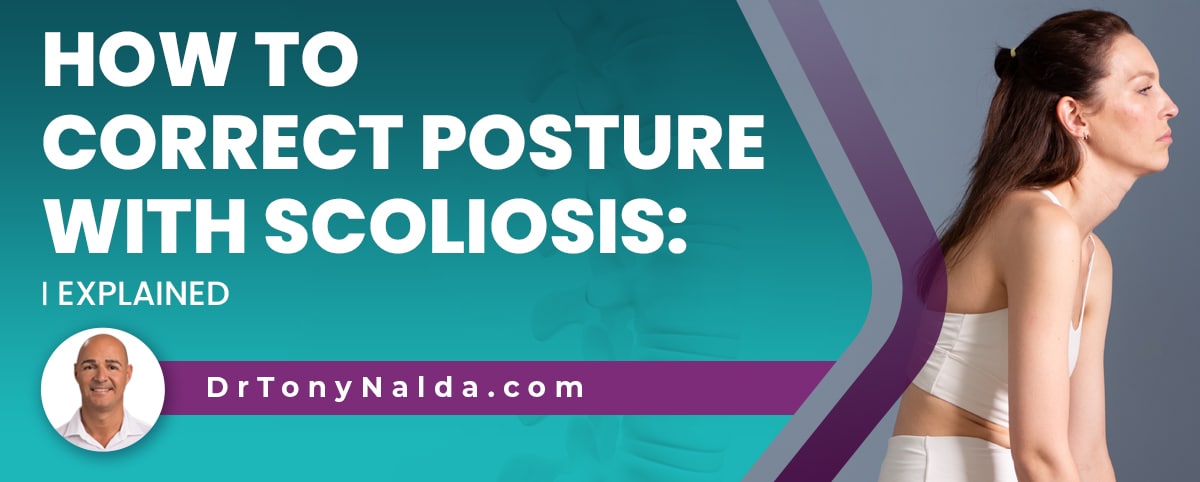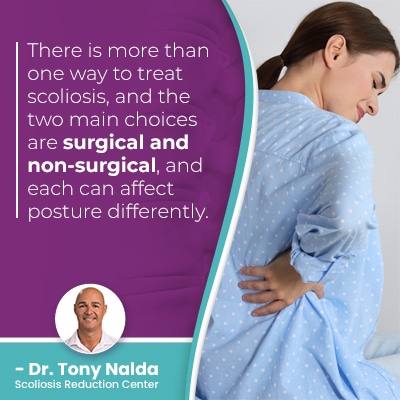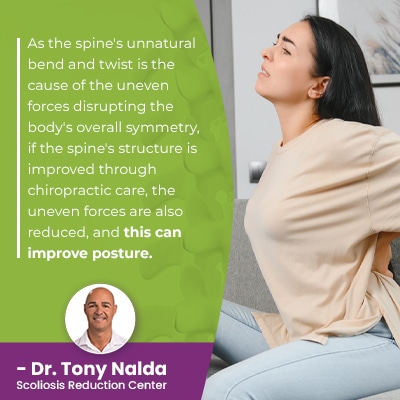How To Correct Posture With Scoliosis: Explained

Scoliosis is associated with a number of effects, including postural changes and pain. The most common effect in adults is pain, and the most common symptoms of childhood scoliosis involve postural changes like uneven shoulders and hips.
Scoliosis can introduce a lot of uneven forces to the body that disrupt its overall symmetry. The best way to correct postural changes caused by scoliosis is to treat the condition proactively by addressing its structural nature and effects.
Correcting postural changes caused by scoliosis involves proactively addressing the condition's underlying structural nature.
Table of Contents
Treating Scoliosis
When it comes to treating scoliosis, being proactive has its benefits.
A proactive scoliosis treatment plan involves being started as close to the time of diagnosis as possible, and this is due to the condition's progressive nature.
The nature of scoliosis is to get worse over time, and this involves the size of the unnatural spinal curve increasing, as do the condition's uneven forces, and their effects.
Treating scoliosis is the best means of minimizing the condition's effects, including postural changes.
After scoliosis is diagnosed and further classified based on condition type, severity, curvature location, and condition severity, treatment plans can be customized accordingly.
There is more than one way to treat scoliosis, and the two main choices are surgical and non-surgical, and each can affect posture differently.
Condition Severity and Posture
 When scoliosis is being assessed and diagnosed, part of the process involves further classifying conditions based on a number of key variables, one of which is condition severity.
When scoliosis is being assessed and diagnosed, part of the process involves further classifying conditions based on a number of key variables, one of which is condition severity.
Scoliosis is a highly-variable condition that ranges widely in severity from mild scoliosis to moderate scoliosis, severe and very severe scoliosis.
The more severe a condition is, the larger the size of the unnatural spinal curve is, the more rotation there is in the spine, and the more likely the condition is to cause noticeable postural changes.W
When mild, postural changes can be subtle and difficult for anyone, other than a scoliosis expert trained in what to look for, to recognize, and it's a common scenario that scoliosis is diagnosed once it has progressed significantly, causing noticeable effects.
The more severe a condition, the more unnaturally tilted the spine's vertebrae are, the larger the size of the unnatural spinal curve will be, and the more noticeably it will disrupt posture.
Surgical Treatment and Posture
Surgical treatment for scoliosis commonly involves spinal fusion surgery and involves fusing the curve's most-tilted vertebrae and attaching metal rods to the spine to hold it in place.
The goal of a surgical response is to stop progression, but this isn't the same as correcting scoliosis, which we'll return to later.
Scoliosis surgery only addresses the spine, however, and not the rest of the body, and scoliosis doesn't just affect the spine, but also its surrounding muscles, nerves, and the entire body.
Many patients undergo surgery because they think it's their only, or the best, option for restoring healthy posture, but many are disappointed.
Spinal fusion can stop the spine from becoming more unnaturally bent and twisted, but it can cost the spine in terms of its overall health, strength, and function, and the surgery does little to reverse postural changes caused by the condition.
There is another treatment option, however, that addresses the condition's structural nature along with many of its postural changes.
Non-Surgical Treatment and Posture
The best way to correct posture with scoliosis is to address the underlying cause of the changes: the condition itself.
Addressing the condition's underlying structural nature is addressing the underlying cause of related postural changes; it's the structural abnormality within the spine itself that's introducing uneven forces to the body.
So to address the spinal curve's unnaturally-tilted and rotating vertebrae, a non-surgical treatment plan can include condition-specific chiropractic care that works towards adjusting the position of the excessively-tilted vertebrae into a straighter alignment with the rest of the spine.
Chiropractic Care and Posture
A series of condition-specific chiropractic techniques and manual adjustments can work towards a curvature reduction that occurs as the spine's alignment is improved.
As the spine's unnatural bend and twist is the cause of the uneven forces disrupting the body's overall symmetry, if the spine's structure is improved through chiropractic care, the uneven forces are also reduced, and this can improve posture.
Physical Therapy and Posture
Physical therapy can help improve postural changes by increasing the strength of the spine's surrounding muscles so they can optimally support and stabilize the spine.
Physical therapy and the prescription of corrective scoliosis exercises can also help improve posture by addressing a muscle imbalance associated with scoliosis.
Scoliosis doesn't just affect the spine, but also its surrounding muscles, and as the unnaturally-bent and twisted spine can pull its surrounding muscles in different directions, the muscles on one side of the spine can become weak from underuse, while muscles on the other side can become sore and stretched from strain and overuse.
When the spine's surrounding muscles are unbalanced, it's even harder to maintain good posture and an economical gait, and changes to balance and coordination are also common.
Corrective Bracing
Corrective bracing is a common facet of childhood scoliosis treatment as bracing works towards pushing the spine into a straighter alignment, and when combined with other types of corrective treatment, it can be valuable.
Corrective bracing forces the spine to be straighter, and this also improves the body's center of gravity as the spine becomes straighter, more balanced, and more stable.
How Does Scoliosis Affect Posture?
 It's the uneven forces of scoliosis that affect posture, and common postural changes can include uneven shoulders, uneven hips, the development of a rib cage arch, arms and legs hanging at different lengths, and these changes can make clothing suddenly seem ill-fitting.
It's the uneven forces of scoliosis that affect posture, and common postural changes can include uneven shoulders, uneven hips, the development of a rib cage arch, arms and legs hanging at different lengths, and these changes can make clothing suddenly seem ill-fitting.
Progression can happen quickly, particularly in the condition's most-prevalent form, adolescent idiopathic scoliosis, and postural changes will become more overt as the abnormal curvature of the spine gets larger.
It's growth that triggers progression, which is why childhood scoliosis should always be taken seriously.
So where a patient's posture is at the time of their diagnosis doesn't always indicate that's where it will stay, particularly if left untreated or not treated proactively.
Here at the Scoliosis Reduction Center®, the majority of my patients are diagnosed with moderate scoliosis, and this is because it's common that the signs of mild scoliosis are too subtle, and conditions don't get diagnosed until enough progression has occurred to make the postural changes more noticeable, at least in children.
In adults, it's scoliosis pain that most often leads to assessment and treatment.
In adults, a prominent lean to one side is also common, and the postural asymmetries caused by scoliosis are most noticeable when in a forward bend position.
In adults, postural changes will also increase with age-related degenerative scoliosis because the spine is becoming increasingly unbalanced and unstable.
So the best way to correct posture with scoliosis is to treat the condition proactively, and this means preventing progression and increasing effects, like postural changes; what's even better than working towards reversing postural changes caused by scoliosis is preventing their development in the first place.
Conclusion
So when it comes to the postural changes caused by scoliosis, we're talking about disruptions to the body's overall symmetry, due to the introduction of uneven forces.
In children, often the earliest signs of scoliosis include uneven shoulders and hips, and while a surgical treatment response only addresses the spine, a conservative non-surgical treatment approach also addresses the spine's surroundings.
Chiropractic care, physical therapy, scoliosis exercises designed by a corrective exercise specialist, and rehabilitation can all work together to achieve corrective results, and when this happens, the underlying structural nature of the condition has been addressed with a curvature reduction, and the spine's surrounding muscle strength and balance has also been improved.
While there are never treatment guarantees, when it's started early in a condition's progressive line, scoliosis is less complex and simpler to treat, and postural changes are either easier to reverse, or significant progression and related postural changes haven't yet occurred.
One of the main benefits of a conservative non-surgical treatment approach is that it's proactive and values helping patients avoid progression that can lead to a surgical recommendation in the future.
There are entire exercise-based treatment programs that aim to improve posture and postural awareness such as Schroth exercises as part of the Schroth method and SEAS (scientific exercises approach to scoliosis).
Maintaining good posture is important for practicing a spine-friendly lifestyle, and postural correction is part of a conservative non-surgical scoliosis treatment approach that includes reducing an unnatural spinal curvature to correct scoliosis.
Dr. Tony Nalda
DOCTOR OF CHIROPRACTIC
After receiving an undergraduate degree in psychology and his Doctorate of Chiropractic from Life University, Dr. Nalda settled in Celebration, Florida and proceeded to build one of Central Florida’s most successful chiropractic clinics.
His experience with patients suffering from scoliosis, and the confusion and frustration they faced, led him to seek a specialty in scoliosis care. In 2006 he completed his Intensive Care Certification from CLEAR Institute, a leading scoliosis educational and certification center.
About Dr. Tony Nalda
 Ready to explore scoliosis treatment? Contact Us Now
Ready to explore scoliosis treatment? Contact Us Now





